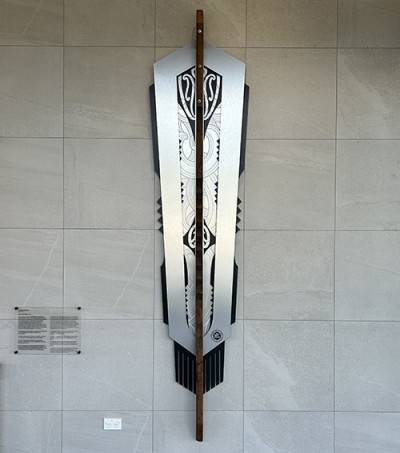Waikato Regional Council launched its Māori language strategy, He Rautaki Reo, during Māori Language Week 2023. The strategy reinforces the council’s commitment to revitalise and integrate te reo Māori into our operations and promote its use. The strategy’s vision is that “Waikato Regional Council is an organisation where te reo Māori is a living language. It is a place where te reo Māori is valued, learning to speak it is supported and celebrated. The language is seen, read, heard and used across the organisation, on a daily basis.”

This artwork, Manu Karanga, is one of a collection at our Ward Street office. The first seen when you enter the building, the art represents a karanga to welcome you to this space.
The Waikato Regional Council takes its Treaty and related responsibilities seriously, and continuously improving our capabilities to work in te ao Māori spaces will become essential as we face greater expectation and need to do so. Our work means we partner with iwi and work closely with a broad range of people, organisations and communities across our vast region. Council staff increasingly need familiarity with and understanding of te reo Māori to capably and confidently perform their roles as we work to sustainably manage our region’s natural resources.
Māori organisations and people form a significant and growing part of our customer base. In 2018, 23.9 per cent of people in the Waikato (109,500) were Māori, and Stats NZ’s 2023 mid-range projections anticipate this number will grow to approximately one-third (174,800) by 2043. Waikato’s ability and appetite to use te reo is growing too. In 2018, 24 per cent of the total Waikato regional population over 15 said they were able to speak ‘more than a few words or phrases of te reo Māori’ and by 2021, this proportion had grown to 30 per cent.
Today, Waikato Regional Council has eight key iwi partners and the region is home to 26 hapū entities, 49 iwi authorities and 178 marae. The Waikato-Maniapoto Māori Land Court district includes over 143,000 hectares of Māori land, which is about 6.6 per cent of the total area. The council’s Director of Customer, Community and Services, Neville Williams, says if you look at the region’s land and its people, having a Māori language strategy makes perfect sense: “For us it’s not a question of why have a Māori language strategy, but more of how would we do our job properly without one?”
He rautaki reo builds on existing work to improve staff capability in te reo. A staff survey in 2016 revealed that only 15 per cent of staff thought no or very little te reo was needed in their current role; 41 per cent felt that simple greetings and correct pronounciation would be useful and 29 per cent thought being able to say a brief mihi and ask simple questions would help in their roles. Our 2022 cultural competency survey showed broad interest and genuine willingness among staff to grow and develop confidence and competency in te reo Māori. We’re making real progress but have room to grow: 82 per cent of staff said they were capable of exchanging informal greetings, but almost two-thirds of these staff needed support or lacked confidence.
Pou Tūhono Mali Ahipene manages the council’s kaupapa Māori team, Tai-ranga-whenua, and says building staff capability is an ongoing process but it’s very much part of day-to-day life at Waikato Regional Council: “We have some well-established resources and programmes in our learning and development suite with enthusiastic uptake from both Māori and non-Māori staff. And we are always looking at ways to provide more opportunities so staff can keep adding to their kete of knowledge. This strategy affirms that work.”
Mali says te reo Māori is also centrally important to Māori culture, customs, history, knowledge systems, and identity. It is a taonga to be sustained through intergenerational community transmission: “He rautaki reo shows our commitment to the revitalisation and use of Te Reo Māori in our organisation. It promotes its use and celebrates its importance within the wider community. At the same time, it helps the council work towards achieving our corporate strategic partnership goals.”



To ask for help or report a problem, contact us
Tell us how we can improve the information on this page. (optional)